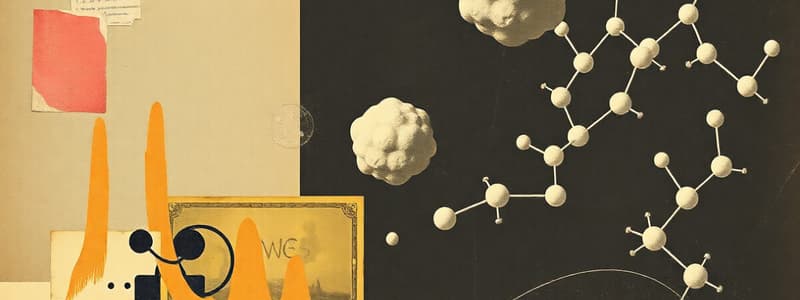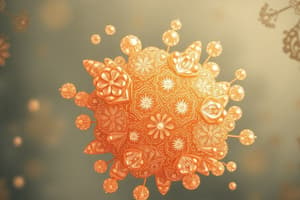Podcast
Questions and Answers
What is the significance of glucose being classified as a reducing sugar?
What is the significance of glucose being classified as a reducing sugar?
- It can enhance the glucose oxidase method's effectiveness.
- It enables the reduction of copper ions in Fehling's reaction. (correct)
- It means glucose can only exist in a cyclic form.
- It allows glucose to undergo oxidation without requiring an enzyme.
Which component is essential for the measurement of glucose using the Hexokinase method?
Which component is essential for the measurement of glucose using the Hexokinase method?
- NADH
- H2O2
- Hexokinase (correct)
- Dianisidine
In the context of glucose oxidase method, what is the final product that indicates the presence of glucose?
In the context of glucose oxidase method, what is the final product that indicates the presence of glucose?
- D-Glucano-δ-lactone
- Colored oxidized dianisidine (correct)
- NADPH
- Glucose-6-phosphate
Why must the glycosidic hydroxyl group be free for reducing properties to be displayed?
Why must the glycosidic hydroxyl group be free for reducing properties to be displayed?
What role does NADP+ play in the Hexokinase method?
What role does NADP+ play in the Hexokinase method?
What is the term used for the interconversion of the two anomers of glucose?
What is the term used for the interconversion of the two anomers of glucose?
Which form of D-glucopyranose is considered more stable?
Which form of D-glucopyranose is considered more stable?
What configuration describes the relationship between α-D-glucopyranose and β-D-glucopyranose?
What configuration describes the relationship between α-D-glucopyranose and β-D-glucopyranose?
At equilibrium, what is the optical rotation of the anomers of glucose?
At equilibrium, what is the optical rotation of the anomers of glucose?
What type of interactions contribute to the stability differences between the two anomers of glucose?
What type of interactions contribute to the stability differences between the two anomers of glucose?
In which form does fructose exist when in equilibrium with its anomers?
In which form does fructose exist when in equilibrium with its anomers?
What is a primary reason for the greater stability of β-D-glucopyranose compared to α-D-glucopyranose?
What is a primary reason for the greater stability of β-D-glucopyranose compared to α-D-glucopyranose?
Which of the following describes the structural difference between α and β D-glucopyranose?
Which of the following describes the structural difference between α and β D-glucopyranose?
What is the general formula for carbohydrates?
What is the general formula for carbohydrates?
Which of the following is classified as an oligosaccharide?
Which of the following is classified as an oligosaccharide?
What role do carbohydrates play in plants?
What role do carbohydrates play in plants?
What is the smallest monosaccharide?
What is the smallest monosaccharide?
Which monosaccharides are considered aldoses?
Which monosaccharides are considered aldoses?
How many stereoisomers can a sugar with three chiral carbons have?
How many stereoisomers can a sugar with three chiral carbons have?
What distinguishes epimers from other sugars?
What distinguishes epimers from other sugars?
What are monosaccharides with a ketone group called?
What are monosaccharides with a ketone group called?
How many stereoisomers can a hexose have if it has four asymmetric carbons?
How many stereoisomers can a hexose have if it has four asymmetric carbons?
Which of the following correctly describes polysaccharides?
Which of the following correctly describes polysaccharides?
What type of monosaccharides are aldoses and ketoses?
What type of monosaccharides are aldoses and ketoses?
What type of carbohydrate serves as inactive ingredients in pharmaceutical formulations?
What type of carbohydrate serves as inactive ingredients in pharmaceutical formulations?
What phenomenon occurs when monosaccharides cyclize?
What phenomenon occurs when monosaccharides cyclize?
Which configuration is predominantly found in natural sugars?
Which configuration is predominantly found in natural sugars?
What are anomers?
What are anomers?
Which of the following statements regarding chiral centers in D-glucose and D-galactose is true?
Which of the following statements regarding chiral centers in D-glucose and D-galactose is true?
What characterizes the cyclic structure of monosaccharides?
What characterizes the cyclic structure of monosaccharides?
Which of the following correctly describes ketohexoses?
Which of the following correctly describes ketohexoses?
Which of the following best describes the nature of glycosidic bonds in disaccharides?
Which of the following best describes the nature of glycosidic bonds in disaccharides?
What is the source of lactose intolerance in individuals?
What is the source of lactose intolerance in individuals?
Which type of polysaccharide is starch primarily composed of?
Which type of polysaccharide is starch primarily composed of?
What type of linkage is primarily found in cellulose?
What type of linkage is primarily found in cellulose?
Which characteristic distinguishes chitin from cellulose?
Which characteristic distinguishes chitin from cellulose?
How does penicillin act on bacterial peptidoglycan synthesis?
How does penicillin act on bacterial peptidoglycan synthesis?
What type of carbohydrate structure is common to glycosaminoglycans?
What type of carbohydrate structure is common to glycosaminoglycans?
What is the primary function of heparin in medicine?
What is the primary function of heparin in medicine?
What feature do lectins possess that allows them to bind carbohydrates?
What feature do lectins possess that allows them to bind carbohydrates?
What does the cluster structure of starch granules consist of?
What does the cluster structure of starch granules consist of?
How do β-lactamases affect antibiotic treatment?
How do β-lactamases affect antibiotic treatment?
Which of these sugars could be classified as a non-reducing sugar?
Which of these sugars could be classified as a non-reducing sugar?
Flashcards are hidden until you start studying
Study Notes
Carbohydrate Definition & Classification
- Polyhydroxyaldehydes or polyhydroxyketones with general formula (CH2O)n.
- May contain nitrogen, sulfur, or phosphorus.
- Exist in linear or cyclic forms.
- Include oligomers and polymers that can form these compounds upon hydrolysis.
- Also known as saccharides, with names ending in "-ose".
- Classified by their monosaccharide units:
- Monosaccharides: Single unit of polyhydroxyaldehydes or ketones (e.g., glucose, fructose, erythrose, etc.)
- Oligosaccharides: Few units linked by ether bonds (e.g., sucrose, a disaccharide containing glucose and fructose).
- Polysaccharides (Glycans): More than 20 monosaccharide units (some have 100,000+ units). They can be linear (e.g., amylose) or branched (e.g., amylopectin, glycogen).
Carbohydrate Roles
- Energy generation and storage: The primary energy source in metabolism through oxidation.
- Structural role: Found in plants (cellulose), bacterial cell walls, and insect exoskeletons.
- Inactive ingredients (excipients): Used in tablets, capsules, and other pharmaceuticals.
- Osmolites: Contribute to osmotic pressure inside and outside of cells.
- Recognition elements: Involved in immunity, immune responses, and cell identity/recognition.
Monosaccharide Types & Nomenclature
- Two main types: polyhydroxyaldehydes (aldoses) and polyhydroxyketones (ketoses).
- Classified by the number of carbon atoms:
- Trioses
- Tetroses
- Pentoses
- Hexoses
Monosaccharide Chirality
- Smallest monosaccharide is glyceraldehyde, which has two stereoisomers.
- Most natural sugars have a D relative configuration.
- Dihydroxyacetone is a ketotriose with no stereoisomers.
Monosaccharide Series: Aldoses
- Most natural sugars have a D relative configuration.
- Each chiral carbon generates two enantiomers.
- A sugar with 'n' chiral carbons has 2n stereoisomers.
- Only half of these stereoisomers will have the D-relative configuration.
Monosaccharide Series: Ketoses
- Refer to provided image (Figure 8 in the original text).
Monosaccharide Series: Epimers
- Two sugars that differ only in the configuration of one chiral carbon atom.
Hexose
- Includes aldohexose and ketohexose examples.
- See figure 10 for structural representations of D-glucose, D-galactose, D-fructose, and L-galactose.
Monosaccharides: Cyclic Structure
- Monosaccharides exhibit special properties due to the presence of both alcohol and carbonyl functionalities in their molecules.
- Leads to high reactivity.
Monosaccharides: Cyclic Structure - Anomers
- Cyclization creates a new chiral center.
- Two stereoisomers, differing only in stereochemistry at the hemiacetalic carbon, are called anomers.
- Alpha and Beta anomers are shown in the figure 12.
Monosaccharides: Mutarotation
- Glucose and fructose have anomers, these are stereoisomers that differ in their configuration at the anomeric carbon.
- α-D-glucopyranose is 36.4% at equilibrium, while β-D-glucopyranose is 63.5%.
- The interconversion of the two anomers via the acyclic form is called mutarotation.
- The stability of the anomers is dependent on the position of the hydroxyl groups.
- α-D-glucopyranose has an axial hydroxyl group, while β-D-glucopyranose has an equatorial hydroxyl group.
- Equatorial hydroxyl groups are more stable due to less steric hindrance.
- α and β are different configurations, not conformations, and are diastereomers.
Reducing Properties of Monosaccharides
- Glucose is a reducing sugar because it can be oxidized to D-gluconate.
- Copper is reduced from +2 to +1 in the Fehling's reaction, which is a test for reducing sugars.
- Cyclic forms need a free glycosidic OH to display reducing properties.
Glucose Measurement in Diagnosis and Treatment of Diabetes
- Glucose oxidase method is used in testing strips, and the reaction produces a colored product.
- Hexokinase method uses the enzyme hexokinase to convert glucose to glucose-6-phosphate.
- The amount of NADPH produced is proportional to the amount of glucose.
Disaccharides
- Disaccharides contain a glycosidic bond which is formed by dehydration.
- Reducing disaccharides have one free anomeric OH, while non-reducing disaccharides have both anomeric OHs linked.
- Lactose is a reducing disaccharide found in milk, and it is broken down by lactase.
- Sucrose is a non-reducing disaccharide commonly known as table sugar.
- Sucrose is the main circulating sugar in plants.
- Trehalose is a non-reducing disaccharide found in insects.
Oligosaccharides: Cyclodextrins
- Cyclodextrins are cyclic oligomers of D-glucose linked α1→4.
- The most common cyclodextrins have 6, 7, or 8 glucose units (α, β, γ-cyclodextrins).
- They have a toroidal structure with a hydrophilic exterior and a hydrophobic interior.
- They can form host-guest complexes with lipophilic drugs.
Polysaccharides: Constitution and Topology
- Polysaccharides are polymers of monosaccharides.
- Homopolysaccharides are made up of the same type of monosaccharide, while heteropolysaccharides are made up of different types of monosaccharides.
Fuel-Storage Homopolysaccharides
- Starch is a mixture of amylose and amylopectin, which are polymers of D-glucose.
- Amylose is a linear polymer linked α1→4, while amylopectin is a branched polymer linked α1→4 and α1→6.
- Glycogen is a branched polymer of D-glucose similar to amylopectin but with more branching.
- Starch and glycogen are storage polysaccharides.
Cellulose
- Cellulose is a linear polymer of D-glucose linked β1→4.
- It is highly insoluble due to inter- and intra-chain hydrogen bonding.
- Cellulose can be used in pharmaceutical formulations as an adsorbent, glidant, suspending agent, and diluent.
Chitin
- Chitin is a polymer of N-acetylglucosamine linked β1→4.
- It is found in the exoskeletons of insects.
- Chitin is similar in structure to cellulose.
Glycoconjugates: Peptidoglycans
- Peptidoglycans are a major component of bacterial cell walls.
- They are made up of repeating disaccharide units of N-acetylglucosamine (NAG) and N-acetylmuramic acid (NAM).
- Peptidoglycans are cross-linked by short peptides.
- Peptidoglycans are essential for bacterial cell wall integrity and are targeted by antibiotics like penicillin.
Synthesis of Bacterial Peptidoglycan
- Penicillin inhibits the transpeptidase enzyme, which is responsible for cross-linking peptidoglycans.
- This weakens the bacterial cell wall and can lead to bacterial cell lysis.
Penicillins: General Structure and Representatives
- Penicillins have a β-lactam ring and a thiazolidine ring.
- Examples of penicillins include ampicillin and amoxicillin.
Penicillins: Mechanism of Action
- Penicillins bind to the active site of transpeptidase, preventing the formation of cross-links in peptidoglycans.
Penicillins: Mechanism of Inactivation
- Bacteria have evolved to produce β-lactamases, which cleave the β-lactam ring of penicillins, rendering them inactive.
- Clavulanic acid is a β-lactamase inhibitor that can be used to overcome bacterial resistance to penicillins.
Glucosaminoglycans
- Glucosaminoglycans are linear heteropolysaccharides composed of repeating disaccharide units.
- They are found in extracellular matrices and play important roles in cell signaling and tissue structure.
Heparin and Congeners
- Heparin is a highly sulfated glucosaminoglycan that is used as an anticoagulant.
- Heparin has the highest negative charge density of any known biological macromolecule.
- Low molecular weight heparin (LMWH) is a shorter version of heparin.
Oligosaccharide Links in Glycoproteins
- Oligosaccharides are found covalently linked to proteins in glycoproteins.
- They are involved in cell recognition and signaling.
Other Glycoconjugates
- Digoxin is a cardiac-active glycoside extracted from foxglove.
- It is used in the treatment of heart failure and atrial fibrillation.
- It contains a tri-digitoxose sugar molecule linked to an aglycone steroid.
Lipopolysaccharides
- Lipopolysaccharides are found on the surface of gram-negative bacteria.
- They are recognized by vertebrate immune systems.
Oligosaccharide Recognition: Lectins
- Lectins are proteins that bind carbohydrates with high affinity and specificity.
- They play important roles in cell-cell interactions and immune recognition.
Studying That Suits You
Use AI to generate personalized quizzes and flashcards to suit your learning preferences.




